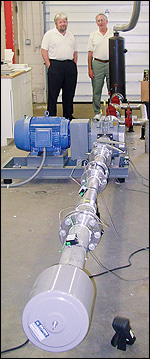Archives
Protecting against biological attacks
BioBlower passes federal tests; patent to be issued soon
By ELLEN GOLDBAUM
Contributing Editor
A powerful air sterilization technology developed at UB has killed every biological agent with which it has been challenged, including airborne spores, viruses and bacteria in independent tests conducted for the U.S. Department of Defense.

BioBlower, shown here with developers
(from left) James Garvey and John Lordi, is moving closer to being used
to protect soldiers from biological attack.
PHOTO: ELLEN
GOLDBAUM
A prototype produced by Buffalo BioBlower Technologies LLC, a UB spin-off company, destroyed biological agents to a level of better than one part per million in an independent evaluation conducted over a period of four weeks by the Research Triangle Institute for the U.S. Department of Defense Joint Program for Chemical and Biological Defense Collective Protection.
In a related development, UB recently received a Notice of Allowance, indicating that a U.S. patent will issue soon covering the BioBlower technology.
“Everything from hospitals, first-responder units and postal facilities to government buildings and mass-transit systems could benefit enormously from the security and peace of mind generated by this device,” said U.S. Rep. Louise M. Slaughter, who secured the funding from the Department of Defense. “Once again, our region is serving as a leader in technological development, and it is this labor and innovation that are benefiting people both locally and throughout our country.”
The positive outcomes in the independent evaluation indicate that BioBlower could, in the near future, be protecting soldiers from biological attack, according to James F. Garvey, professor in the Department of Chemistry, College of Arts and Sciences, and co-founder and chief technical officer of Buffalo BioBlower Technologies with John Lordi, chief executive officer.
Lordi is a research professor in the Department of Mechanical and Aerospace Engineering in the School of Engineering and Applied Sciences. James D. Felske and Joseph C. Mollendorf, professors in the same department, are co-inventors with Garvey and Lordi.
“This independent third-party validation of our technology was so exceptionally compelling that the military has now directed us to retrofit one of their existing platforms with a BioBlower as a technology demonstration,” Garvey said.
The military system now being retrofitted with BioBlower is used to inflate the hospital units and temporary shelters erected in the battlefield for command headquarters.
“We’re removing their current fan and replacing it with our electrical air pump, the BioBlower, which also will instantly kill any airborne biological agents on contact,” Garvey said.
Conventional technologies involve the use of HEPA (high-efficiency particulate air) filters, which simply trap large airborne spores. These passive filters have to be regularly replaced and properly discarded, posing a further potential hazard to personnel, Garvey said. In addition, they provide little or no protection against airborne viruses.
“Right now, it’s up to soldiers in the field to swap out these filters and replace them, which involves considerable logistic demands, such as labor and expense,” said Garvey.
In contrast, he noted, the BioBlower immediately kills any and all airborne biological pathogens and only electricity is needed to power the rotary air pump, which drives the blower.
“With the BioBlower, there’s nothing to replace and no maintenance,” said Garvey. “It’s really ‘plug and play.’ You plug in the machine and as long as it’s running, it’s doing its job.”
BioBlower units are inherently scalable, said Garvey, and can be installed as a permanent part of a building's air-handling (HVAC) system, including on military bases.
The technology also has potential applications in health care and hospital settings to ensure a sterile environment. The New York State Foundation for Science, Technology and Innovation (NYSTAR) currently is funding development of a BioBlower prototype for health care settings with the goal of taking it into clinical trials.
BioBlower also has application to the home health care setting, a market poised to experience tremendous growth in coming years, said Garvey, who adds that a small portable unit could completely sterilize all of the air in any room in the house.
The BioBlower technology moved out of UB’s laboratories and into the commercialization phase thanks to funding from several sources, including the U.S. Department of Defense, secured by Slaughter; UB’s Office of Science Technology and Economic Outreach; NYSTAR; and the UB Center for Advanced Biomedical and Bioengineering Technology, part of UB's New York State Center of Excellence in Bioinformatics and Life Sciences, where Buffalo BioBlower Technologies is based.
BioBlower is based on a modification of a Roots blower, a mechanical air-pump technology that has been in existence for more than 100 years and has been used for a range of applications from vacuum pumps in research laboratories to superchargers for drag-racing "funny cars."
The BioBlower destroys airborne pathogens by rapidly heating the contaminated air under pressure and mechanically compressing it as it is being blown rapidly through the mechanical rotary pump. The system then blows the disinfected air back into the enclosed environment, whether it is a tank, plane, ship, tent or building.
